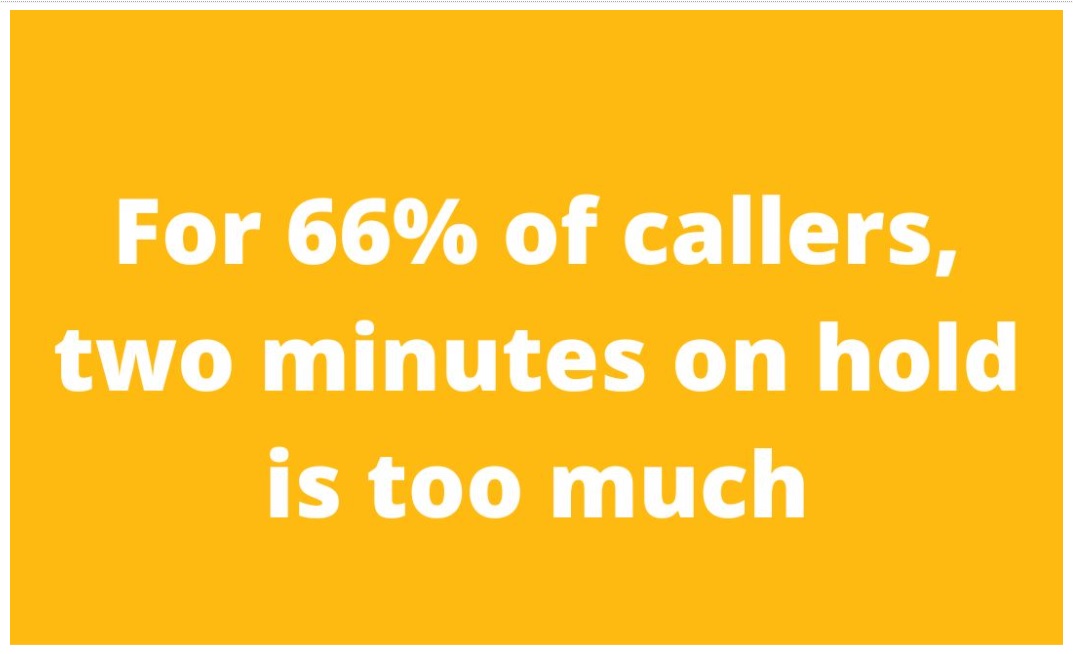Everything you need to know about call queues
We’ve all experienced it: we try to get through to our car insurance contact centre only to get stuck listening to a harp rendition of ‘Total Eclipse of the Heart’ hold music. On repeat. We might think that our call was the first of the day, so what gives? While we wait for someone to become available, the mind wanders. Why do they have this call system? Is it really effective? Is it going to cut me off?
Let’s take a look at everything you should know about call queues.
What is a call queue?
As you may have gathered, a call queue is a function in a business phone system that funnels inbound calls. It’s when you call up a company, usually to speak to a customer service rep, and get put automatically in a queue, waiting to speak to someone who can handle your request.
Unlike with voicemail systems, there are usually a series of automated IVR (Interactive Voice Response) questions you have to answer out loud or by keying in different numbers. Your request is then categorised, and then, hopefully, you’re not just redirected to their website (isn’t that just the worst?). IVRs or auto attendants are now a fairly standard part of most automated phone systems.
Common steps in the call queue system

There are typically a few basic steps that are followed with call queues. First comes the automated greeting, then incoming calls are distributed across different agents, and sometimes inbound calls are routed to particular agents depending on the nature and reason for your call.
Automated greetings

‘Hello, and thank you for calling our customer support team. We are experiencing an unprecedentedly high volume of calls at the moment, so we have placed your call in a queue. You are currently in place number 17,393, and your estimated wait time is one light year, 23 push-ups, and seven milkshakes. Your call is very impozrtant to us, and our next available agent will get to you as soon as possible – sometime after they’ve been born.’
Or something like that.

Call distribution
Then, once an agent does become available (assuming you don’t hang up/are still in the land of the living), your call is distributed to said available agent. All the other callers humming along to the same beloved, but by now, hellish Bonnie Tyler tune also get distributed to various agents as they become available.
Call routing
Call routing is the process by which your call is transferred to the appropriate agent, rather than simply the next available agent. So, instead of being directed to someone with only general knowledge of the company and/or product, you will get directed to someone with relevant knowledge and information who can help you most efficiently.
Call queue key benefits
So as you can probably guess, call queues were not invented to introduce people of all ages to classic rock anthems, nor were they invented to make anyone jump through endless hoops or question their sanity. There are actually quite a few benefits that most of us probably don’t think about when we hear a prerecorded message instead of a live, real-time human (and take an embarrassingly long time to realise this fact).
Allocate calls fairly to all available agents
The first benefit of call queuing is that agents get a fair distribution of work sent their way. This ensures that it isn’t always the same couple of people dealing with the lion’s share of work. This is beneficial to the customer because they don’t get an overtired, run-down agent struggling to make heads or tails of their fortieth call that morning.
It’s also obviously a huge benefit to the agents who want to avoid getting burned out first thing on a Monday morning. That’s a Wednesday afternoon thing.
Reduce wait times
While we joke about infinitely long waiting times, call queues and queue callback systems actually reduce the amount of time customers need to wait in order to speak to an agent. This is because it’s a much more efficient system than waiting for an undefined amount of time, only to be sent around a series of agents who can’t handle your query. With call queuing, call forwarding is efficiently directed to the right person within the timeframe stated.
It’s also often faster than searching for the answer to your query on the FAQ page of many websites. Perhaps we have just become accustomed to having our queries answered very quickly with the advent of search engines, but that’s the world we live in! The bar for customer satisfaction has been raised with the digital revolution.
Minimise call abandonment

Have you ever been to a really busy restaurant, and there are no tables available, and the waiter said, ‘Well, you can grab a drink at the bar if you like, and we’ll call you whenever a table becomes available’? And you look around, and you have no idea if the other people have even ordered yet, let alone if anyone will be leaving anytime soon.
So you abandon your mission and head over to another restaurant, but it’s also full. This time, however, the waitress tells you that there should be a table available within the next 15 minutes, and that you should go ahead and order something at the bar. You now have a timeframe. You know you will be loading up on nachos in around 25 minutes.
As it turns out, people like knowing how long they have to wait. Tom Hanks in Castaway would probably have felt a lot more peaceful on that island if he knew exactly when he would manage to make it back home. So a call queue, where you’re given a number in the line and told roughly how much time you have to wait to speak to an agent, leads to fewer abandoned calls than when you’re just put on hold indefinitely.
There could be an agent just around the corner, or they could be hours away. With a call queue, customers don’t have to take a gamble, and abandonment rates go down.
Increases agent productivity

Anyone would be more productive if only relevant work that matches their skillset was sent their way. They could focus on what they’re good at and get stuff done in time for dinner. Having a system send work your way every time you get off the phone from a previous caller also increases productivity because it reduces the amount of time agents spend waiting for the phone to ring. The call flow is more natural and intuitive.
And better productivity leads to a smaller backlog of work, more relaxed office vibes, team collaboration and a general sense of well-being and getting stuff done.
Keep customers on the phone until an agent is available
As we mentioned earlier, knowing how long you have to wait is a great motivator for, well, waiting. A call queuing system that’s organised and easier to deal with than other modes of communication will keep customers around. Knowing that you’re being sent to a relevant agent and that you’ll actually get to speak to someone are also great motivators for staying on the line.
Improves customer service
Nothing really beats the personal touch. Getting to speak to an agent often feels a lot more helpful than just talking to a bot or scanning the FAQ section of a website. This system is efficient and effective as you narrow down what you want to talk about before you speak to anyone, and you get to talk to a human in real time at the end to boot.
Common reasons for a long call queue
Sometimes you call up a company, and within seconds, you’re on the line with an agent, and you just breeze through the call effortlessly, collecting all the answers to your questions along the way while you send an SMS and cook your breakfast eggs at the same time.
At other times, the call queue is unusually long even though you called in at the start of their business hours, and the efficiency of these systems seems somewhat lacking, which is less than ideal. So what are some of the reasons behind these kinds of unfortunate scenarios?
Low-quality agent training
If an agent hasn’t been trained appropriately to deal with the queries that come into their call centres, it makes sense that they will take an inordinate amount of time to solve whatever issue people may have called in about. What ends up happening is they have to ask their call centre team members or manager for support, which is just a big time sink. Or worse, they flounder and try to figure it out without help.
Proper call centre training is easier to come by now with more resources than ever available online and in person, and continuous training can help teams keep up with the changing landscape of customer service.
Lack of employees

Sometimes the training is on point, but there just aren’t enough people in the office to get through all of the incoming calls quickly. There’s only so much that the most productive people in the office can do by themselves. There’s only so much you can juggle with one hand.
Some companies get around this issue by outsourcing work, and other organisations just bite the bullet and hire more people. Many simply shuffle around their rotas to get more people in during peak call hours when they are most needed.
Poor workforce administration
Sometimes there are plenty of people in the office, and they all have stellar, top-of-the-line training. But then in comes a poor admin system, and you get days and times with way too many agents handling a small number of inbound calls or way too few agents trying to wade through a tsunami of calls.
A good administration system will work in such a way that the right number of people are in at the right time and have access to all of the equipment that they need. Admin can be pretty dull, we won’t beat around the bush about that, but it sure is useful for the smooth running of any kind of business.
Outdated systems
All companies have a budget. Some budgets allow for updating the call queue system, but others aren’t so big. Outdated queuing systems can slow down the process in comparison to other, newer systems simply because they’re old and don’t benefit from all the improvements that have evolved.
Outdated systems may also be harder to fix when bugs crop up because it could be more difficult to source the right technicians with the knowledge needed as the world moves on to newer and better systems.
It could also be the case that your recorded messages need to be updated with current information, or it’s just time for a little refresh.

Insufficient self-service resources for customers
Obviously, calling a company isn’t the only way to find the answers you seek. If there are enough answers on the website, or you can use a bot to find out what you need to know through an automated messaging system, then you don’t need to call the company at all. Long queues are often caused by customers being unable to find the information anywhere else.
An easy fix for this would be to simply improve your company’s FAQ page, making it more complete with useful answers, easier to find and easier to navigate.
High volume of callers/peak seasons
Certain times of the year are just a little busier than others and can lead to long hold times. Sometimes, things outside of our control can trigger high volumes of calls, such as natural disasters or political changes. Sometimes, the cause of a longer hold time is smaller but still significant, like a website outage. And certain times in the week, month and year are just busier than others, possibly because of when people are at work, eating or on holiday.
If you can use historical call data to see when there have been high volumes of calls in the past and if you can identify the trigger, then you can probably figure out with some degree of accuracy when you will have another peak in the future. The more data you can gather and analyse, the better your chance of mitigating this issue.
Poor documentation

Keeping a good record of callers, their phone numbers and their requests can save a lot of time if they need to be called back or if they call in again. Poor record-keeping, on the other hand, can lead to duplicate information requests and multiple agents going through the same lists of questions, which is a huge time waster.
Simply having a reference number or keeping track of a person’s name and phone number along with notes can massively speed things up. And this information should, of course, be kept on file so that any agent interacting with that same customer can pick up where another left off.
Unsuited call centre software
There are different types of software along with call centre headsets and other hardware available for different types of call centres and team management styles. Choosing the right one for any given company, with the right functionality and integrations, can take time.
An unsuitable choice, such as one without round-robin scheduling, can mean that people don’t work as intuitively. The software also needs to be user-friendly, easy to configure and offer training. Software that falls short of these requirements can slow your team down.
You want to find software that has good reviews and enjoys a handy IT team ready to intervene if there are ever any problems. It should suit the size and work style of your company. Your budget is also an inescapable factor in everything, so focus on the best quality for pricing and your requirements.
Best practices for optimising call queue management

Okay, so now that we’ve narrowed down some of the reasons for long waiting times, how can we improve the call queue service for enhanced customer experience? Let’s delve into some ideas here.
Proper workforce management
One of the main things to sort out for an efficient call queue is how we manage our workforce. This means hiring the right people, giving them appropriate and ongoing training, and finding a schedule that fits everyone and also fits the company.
Looking at the most recent interviewing and hiring advice and research is key to getting the right people into the posts. A good onboarding experience will help with staff retention and the ability to quickly learn how to do the job. Continuous training is also essential for keeping staff motivated and up to date with the software and any changes that arise and offering staff a sense of progress and upward mobility in the company.
A staff work schedule which takes into consideration the peak times and call volumes, staff knowledge and training, and staff requirements for their work-life balance is very important in order to manage call volumes effectively. It also helps to keep employee satisfaction levels high and improve staff retention rates.
Implementing Interactive Voice Response (IVR)
Interactive voice response is basically a conversation with a prerecorded set of responses using specialist voice recognition software. Unless you have a really thick Scottish accent (have you seen that elevator clip with the two men trying to get to the eleventh floor?), the idea is that you can be understood by the software. The software then narrows down the general area you need help with. Then, the appropriate member or members of staff can be assigned to your call.
How does this help with optimisation? It means that the time spent waiting to talk to a customer service representative isn’t wasted – instead, this time is spent finding out as much as possible about your case so that when the agent takes your call, they have all that information immediately available to them.
Performance Analysis and Monitoring

Some companies will monitor their agents’ calls to get a sense of where they’re doing well and which areas they need to improve upon. As well as call recording and listening directly to calls, they can also look at how long their agents’ calls generally last, how many people they manage to speak to, how many cases they resolve and how they are rated by the customer.
These KPIs (key performance indicators) can help managers get a sense of their call centre analytics, such as who needs a little extra support or training as well as what type of training and support they need.
Introduce self-service options
The more that can be done without actually talking to an agent, the lighter the workload and the shorter the call queue waiting times will be. Self-service options can be over the phone and automated. They can also take place via chatbots and FAQ sections of websites and social media.
These would have to be of a high enough standard that they actually remove the need for customers to call you, reducing the overall number of calls you receive. If you have an FAQ section that is unhelpful or incomplete or a chatbot that just redirects you to a dud FAQ page or tells you to call an agent, that’s not super helpful and just ends up wasting more of the customer’s time.
So, make sure your chatbot is actually useful, that your FAQ section is detailed, clear and thorough, and that all of your web pages work properly.
Provide a callback option

Offering your customers the option of a callback at a later time is a massive time saver both for your company and for your customer. This means that overloaded agents can call back at a time when the peak volume of calls has passed and have a more even working day without miserable customers waiting for aeons on the phone.
This also means that customers can go about their day without having to be stuck on the phone just in case someone picks up. We all know how that goes – the postwoman rings the doorbell, the dog barks, your phone nestled precariously between your chin and shoulder as you try to sign for a package drops and falls into your dog’s water bowl below… and then the whole waiting game begins anew from a different, dryer phone.
The callback option means you can either select a specific time from your virtual agent for a callback (ideal) or a general time slot (also ideal, but you have to keep your phone on loud so that you don’t miss it).
Call groups creation
Callers to contact centres can be grouped into different types, depending on your preferences as an organisation. Much like a ticketing system when you go to the post office and select what it is you want help with that day, you can have group integrations in your software to order callers into groups depending on what they want to talk about that day.
So, everyone wishing to get a refund might be grouped together, and everyone wishing to start a new subscription can be grouped into a separate category. These groups can then be handled by specific agents specialising in those things, or the grouping system can simply help agents identify what the call is about ahead of time.
How to use a call queue system for effective call centre management
Hopefully, this article has given you a solid overview of call queuing and how it can help your call centre manage incoming phone calls with ease. As we’ve learned, there are some key dos and don’ts you should know if you don’t want your callers to feel they are trapped in the Upside Down, while a stressed-out agent tries everything in their power to communicate with them.
It’s so important to be mindful of the main reasons for long queues, such as outdated or unsuitable software, poor training or lack of staff, or even just the time of year. There are many reasons why call queues can be long, and understanding these reasons can help you to circumvent them.
To really ace your call queue management, we’ve learned that techniques such as creating groups, offering self-service options, using IVR, as well as analysing your team’s performance and workflow management can go a long way towards achieving this goal.
Originally published Aug 29, 2022, updated Sep 13, 2022

